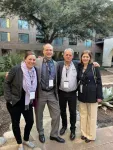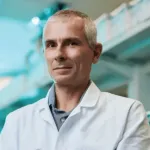(Press-News.org) Key takeaways
Lithium-sulfur batteries have the potential to transform energy storage, with exceptional theoretical capacity and performance in combination with an element in abundant supply. But the intricate reaction mechanism, particularly during discharge, has been challenging to solve.
UCLA researchers have identified the key pathways to a complex sulfur reduction reaction that leads to energy loss and reduced battery life span.
The study’s findings establish the whole reaction network for the first time and offer insight into electrocatalyst design for improved batteries.
Lithium-sulfur batteries can potentially store five to 10 times more energy than current state-of-the-art lithium-ion batteries at much lower cost. Current lithium-ion batteries use cobalt oxide as the cathode, an expensive mineral mined in ways that harm people and the environment. Lithium-sulfur batteries replace cobalt oxide with sulfur, which is abundant and cheap, costing less than one-hundredth the price of cobalt.
But there’s a catch: Chemical reactions, particularly the sulfur reduction reaction, are very complex and not well understood, and undesired side reactions could end the batteries’ lives well before those of traditional batteries.
Now, researchers led by UCLA chemists Xiangfeng Duan and Philippe Sautet have deciphered the key pathways of this reaction. These findings, outlined in a paper published in the journal Nature, will help fine-tune the reaction to improve battery capacity and lifetime.
The sulfur reduction reaction in a lithium-sulfur battery involves 16 electrons to convert an eight-atom sulfur ring molecule into lithium sulfide in a catalytic reaction network with numerous interwoven branches and different intermediate products called lithium polysulfides and many other byproducts. Because it is such a complex reaction, with many paths branching off from each other and many intermediate products that are important for continuing the reaction, it’s been hard to study and even harder to figure out which parts of the reaction to target for improved battery performance.
“Despite extensive efforts devoted to improving the apparent performance of lithium-sulfur batteries, the fundamental reaction mechanism remains unsettled,” said Duan, corresponding author and UCLA professor of chemistry and biochemistry. “The main branch in this reaction network for the sulfur reduction reaction remains a topic of considerable debate.”
A problem of particular interest is a side reaction in which the polysulfide intermediates migrate, called shuttling, to the lithium metal anode and react with it, consuming both sulfur and lithium and leading to energy loss and rapidly reduced storage capacity. A clear identification of the key intermediates and better understanding of how these intermediates are produced or consumed would help scientists control this migration between electrodes and minimize the waste of sulfur and lithium.
The new study deciphers the whole reaction network for the first time, determines the dominant molecular pathway and unveils the critical role of electrocatalysis in modifying the reaction’s kinetics.
The team first used theory calculations to map out all possible reaction pathways and the associated intermediates, and then electrochemical and spectroscopic analysis to validate the computational findings.
Battery performance was dominated by Li2S4 as the main intermediate and catalysis turned out to be crucial for fully converting the Li2S4 to the final discharge product (Li2S). Carbon-based electrodes doped with sulfur and nitrogen can effectively facilitate this conversion. Their study also found that the intermediate Li2S6 does not directly participate in the electrochemical process but is present as a major product from side chemical reactions and contributes significantly to the unwanted polysulfide shuttling effect.
“Our study provides a fundamental understanding of the sulfur reduction reaction in lithium-sulfur batteries and demonstrates that a properly designed catalytic electrode material can accelerate the charging and discharging reactions, mitigate the side reactions and improve the cycle life,” said Duan, who in December was chosen as a 2023 fellow by the National Academy of Inventors.
“The combination of battery technology and catalysis science opens new avenues for fast and high-capacity energy conversion devices,” said Sautet, who is the Levi James Knight, Jr. Term Chair for Excellence.
This work was supported by the Center for Synthetic Control Across Length-scales for Advancing Rechargeables, an Energy Frontier Research Center funded by the U.S. Department of Energy Office of Science Basic Energy Sciences program.
END
Chemists decipher reaction process that could improve lithium-sulfur batteries
A combination of battery technology and catalysis opens new avenues for cheap, high-capacity batteries
2024-02-06
ELSE PRESS RELEASES FROM THIS DATE:
UTEP researchers win inaugural award to support lithium extraction technology
2024-02-06
EL PASO, Texas (Feb. 6, 2024) – A group of researchers at The University of Texas at El Paso are behind an emerging lithium extraction technology that won the inaugural Hill Prize from the Texas Academies of Medicine, Engineering, Science and Technology (TAMEST) on Monday. The $500,000 in prize funds will support a joint research effort by Alma Energy and UTEP to extract lithium from hydrothermal waters.
“If this technology succeeds, it would be a really massive breakthrough in environmentally-friendly lithium extraction,” said Benjamin Brunner, Ph.D., the co-inventor of the technology ...
Complex tree canopies help forests recover from moderate-severity disturbances
2024-02-06
WEST LAFAYETTE, Ind. — Extreme events wipe out entire forests, dramatically eliminating complex ecosystems as well as local communities.
Researchers have become quite familiar with such attention-grabbing events over the years. They know less, however, about the more common moderate-severity disturbances, such as relatively small fires, ice storms, and outbreaks of pests or pathogens.
“Since they’re more common, they’re probably playing a larger role in the ecosystem than we might have appreciated before,” said Brady Hardiman, associate professor of forestry and natural resources and environmental ...
Flu virus variants resistant to new antiviral drug candidate lose pathogenicity, study finds
2024-02-06
ATLANTA — Influenza A viruses with induced resistance to a new candidate antiviral drug were found to be impaired in cell culture and weakened in animals, according to a study by researchers in the Center for Translational Antiviral Research at Georgia State University.
In a study published in PLoS Pathogens, the authors explored the developmental potential of 4’-fluorouridine (4’-FlU), a clinical drug candidate, for influenza therapy. They resistance profiled the compound against influenza viruses and mapped possible routes of viral escape, addressing specifically ...
Microfluidic environments alter microbe behaviors, opening potential for engineering social evolution
2024-02-06
Microbes are social beings.
Much like humans, they communicate and cooperate with each other to solve problems bigger than themselves. In a microbial community, there will even be free riders, and others that police them.
So, what if researchers could influence their social evolution to promote certain behaviors? Doing so can be vital to solving many of today’s challenges such as combating infection and antibiotic resistance, developing microbial strategies for wastewater treatment or harvesting alternative energy sources.
A research group led by Dervis Can Vural, an associate professor in the Department of Physics and Astronomy at ...
Structural isomerization of individual molecules using a scanning tunneling microscope probe
2024-02-06
1. An international research team led by NIMS, the Osaka University Graduate School of Science and the Kanazawa University Nano Life Science Institute (WPI-NanoLSI) has succeeded for the first time in controlling the chirality of individual molecules through structural isomerization. The team also succeeded in synthesizing highly reactive diradicals with two unpaired electrons. These achievements were made using a scanning tunneling microscope probe at low temperatures.
2. It is usually quite challenging to control the chirality of individual molecular units and synthesize extremely reactive diradicals in organic chemistry, preventing ...
Moffitt study suggests improvements needed for patient-reported outcome data in genitourinary cancer clinical studies
2024-02-06
TAMPA, Fla. — Patient-reported outcomes are important indicators of how cancer drugs impact patients’ lives. By assessing the benefits and risks of drugs from a patient’s perspective, scientists and physicians can improve the development of patient-centered drugs and care. In a recent study published in eClinicalMedicine, part of The Lancet Discovery Science, Moffitt Cancer Center researchers demonstrate that there is a significant unmet need for improved analyses and reporting of patient-reported outcomes in genitourinary cancer clinical trials.
Health care professionals have realized that how a disease and its treatment ...
New EU-funded project "FOOD includes" aims to improve the inclusiveness and accessibility of adult education
2024-02-06
In December 2023, the new "FOOD includes" project funded by the European Commission started at the Center for Lifelong Learning at Johannes Gutenberg University Mainz (JGU). Over its 36-month term, the objective of "FOOD includes" is to increase take-up and improve the inclusiveness and accessibility of adult education. The project has been designed for adults with lower academic qualifications and migrants who are less likely to take advantage of continuing education and training opportunities. Therefore, the project focuses on activities revolving ...
New water-focused innovation engine aims to turn waste into wealth for Great Lakes region
2024-02-06
The waste in our water could soon generate new waves of clean energy development, job creation and economic growth across the Great Lakes thanks to a new regional innovation and economic development initiative launched by the U.S. National Science Foundation (NSF). The initiative will fund efforts to find new ways to recover clean water, nutrients and materials for clean energy technologies from wastewater — all while removing dangerous chemicals.
These efforts will be carried out by Great Lakes ReNEW, a collaboration of research institutions, universities, ...
Researchers breathe new life into lung repair
2024-02-06
In the human body, the lungs and their vasculature can be likened to a building with an intricate plumbing system. The lungs’ blood vessels are the pipes essential for transporting blood and nutrients for oxygen delivery and carbon dioxide removal. Much like how pipes can get rusty or clogged, disrupting normal water flow, damage from respiratory viruses, like SARS-CoV-2 or influenza, can interfere with this “plumbing system.”
In a recent study, researchers looked at the critical role of vascular ...
Promoting prosocial behavior in the classroom and beyond
2024-02-06
COLUMBIA, Mo. -- Christi Bergin has devoted 40 years of her life to helping teachers and their students. Throughout her career, she’s noticed two simultaneous trends in the field that seem to be connected: a rise in disruptive classroom behavior, and an exodus of teachers from the profession who leave due to stress and burnout.
To help combat these trends, Bergin, a professor emerita in the University of Missouri College of Education and Human Development, has focused her research on improving prosocial behavior — actions that show kindness, compassion, empathy and respect — in classrooms and communities.
Not ...
LAST 30 PRESS RELEASES:
Learning about public consensus on climate change does little to boost people’s support for action, study shows
Sylvester Cancer Tip Sheet for January 2026
The Global Ocean Ship-Based Hydrographic Investigations Program (GO-SHIP) receives the Ocean Observing Team Award
Elva Escobar Briones selected for The Oceanography Society Mentoring Award
Why a life-threatening sedative is being prescribed more often for seniors
Findings suggest that certain medications for Type 2 diabetes reduce risk of dementia
UC Riverside scientists win 2025 Buchalter Cosmology Prize
SETI Institute opens call for nominations for the 2026 Tarter Award
Novel theranostic model shows curative potential for gastric and pancreatic tumors
How beige fat keeps blood pressure in check
Fossils reveal ‘latitudinal traps’ that increased extinction risk for marine species
Review: The opportunities and risks of AI in mental health research and care
New map reveals features of Antarctic’s ice-covered landscape
Beige fat promotes healthy vascular function and blood pressure in mice
Chronic low-dose pesticide exposure reduces the life span of wild lake fish, China-based study shows
Tiny earthquakes reveal hidden faults under Northern California
Long-term pesticide exposure accelerates aging and shortens lifespan in fish
Professor Tae-Woo Lee's research group develops groundbreaking perovskite display technology demonstrating the highest efficiency and industry-level operational lifetime
The “broker” family helps tidy up the cell
Ecology: Mummified cheetahs discovery gives hope for species’ Arabic reintroduction
Researchers survey the ADHD coaching boom
Air pollution and cardiac remodeling and function in patients with breast cancer
Risk of suicide in patients with traumatic injuries
Post–intensive care syndrome
The lifesaving potential of opioid abatement funds
The Frontiers of Knowledge Award goes to Allan MacDonald and Pablo Jarillo-Herrero for their discovery of the “magic angle” enabling science to transform and control the behavior of new materials
Discovery reveals how keto diet can prevent seizures when drugs fail
JMIR Publications and Sikt announce pilot flat-fee unlimited open access partnership
Finding new cell markers to track the most aggressive breast cancer in blood
A new, cleaner way to make this common fertilizer
[Press-News.org] Chemists decipher reaction process that could improve lithium-sulfur batteriesA combination of battery technology and catalysis opens new avenues for cheap, high-capacity batteries





